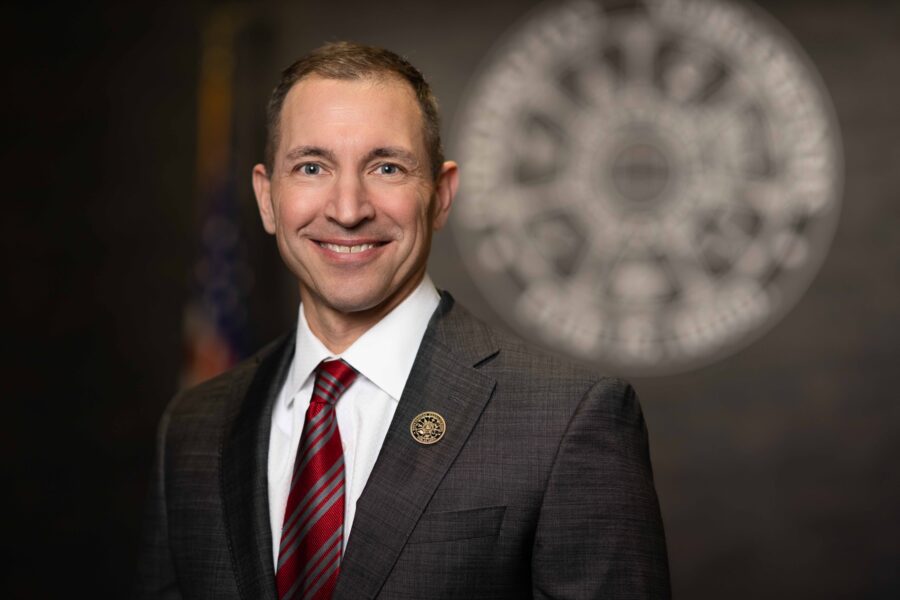The University of Nebraska will be instantly more competitive with the nation’s leading research institutions under a new reporting model announced today by Interim President Chris Kabourek that will unify the research achievements of NU’s flagship university and its medical center.
Beginning with the FY2023 National Science Foundation’s Higher Education Research and Development Survey – the national gold standard for research rankings – the University of Nebraska-Lincoln, University of Nebraska Medical Center and Office of the President will begin reporting their federally funded research expenditures as one combined figure. That survey will be released in November.
Until now, Nebraska’s institutions have reported research figures separately – making Nebraska unlike virtually every other institution in the Big Ten and in the Association of American Universities, the coalition of the nation’s most prestigious research universities that Nebraska aims to be readmitted to. Among the 18 universities in the expanding Big Ten Conference, all but Nebraska are AAU members.
The National Science Foundation approved Nebraska’s proposal to report research as one “University of Nebraska” figure after reviewing Nebraska’s commitment to making structural changes that will align it with the rest of the Big Ten and AAU.
“When it comes to research rankings, we’ve been fighting with one arm tied behind our backs,” Kabourek said. “We’re blessed with incredible faculty on all our campuses, and it makes sense for Nebraska’s two statewide research universities to report their success together. Nebraska is strongest when we are one team. In my mind, it’s Nebraska against the rest of the field.
“I am very pleased that the National Science Foundation has endorsed our plan for closer alignment between UNL and UNMC. In our separate silos, we can’t compete to our full potential. But together as One Nebraska, we instantly start to look like a Big Ten, AAU institution that keeps company with the best of the best. I’m thrilled that we are executing on our plan to go compete for the benefit of faculty, staff, students and all Nebraskans.”
UNMC Chancellor Jeffrey P. Gold, MD, said: “Today’s higher education landscape is the most competitive we have seen in our lifetimes. As a university, we owe it to ourselves and to all Nebraskans to do everything we can to put ourselves in a position to compete. We at UNMC recognize the great benefits that come from a close relationship with UNL. The urgent challenges we face around health care, national security, and water and agriculture can only be solved with all the best minds around the table. There is only upside that can come from the talents and expertise of UNMC and UNL in delivering bold solutions for Nebraska and the world.”
The current HERD survey ranks UNMC 120th in the nation in federally funded research and development. UNL is No. 122, second to last in the Big Ten and the only Big Ten school other than Oregon that is not in the top 60.
Reported together, along with the Office of the President, which includes system-wide entities such as the National Strategic Research Institute, Nebraska vaults to approximately 64th in the country – closer to the pack of its Big Ten peers.
Kabourek cautioned that while unified research reporting isn’t an overnight solution to Nebraska being readmitted into the AAU, it’s a deliberate action in support of the university’s public declaration to improve its competitiveness and national stature.
Unified research reporting was a key component of the Five-Point Plan that the University of Nebraska released last summer following a directive from the Board of Regents to build a proactive strategy for navigating the challenges facing higher education. As part of that plan, university leaders are rethinking resource allocations across the system in order to improve Nebraska’s competitiveness in research, academics, student recruiting, fiscal effectiveness and other areas. In line with the board’s directive, structural changes that will best position the University of Nebraska to compete are part of the conversation.
Board of Regents Chairman Tim Clare of Lincoln praised the new research reporting model.
“This is a big deal for Nebraska, and frankly an overdue move,” Clare said. “I couldn’t be more proud of the team for getting this done. Nebraskans expect and deserve a university that competes at the highest levels. With actions like this, we’re sending a strong message that the University of Nebraska wants a seat at the table with the nation’s best and that we’re willing to do the hard work necessary to get there.”
“The University of Nebraska-Lincoln enjoys a strong collaborative relationship with our colleagues at UNMC. When we work together, big things happen for Nebraska,” said UNL Chancellor Rodney D. Bennett, EdD.
“We know we have the potential to create even greater impact for Nebraskans and people around the world. President Kabourek has challenged us to hold ourselves to uncommonly high expectations, and this new research reporting model is consistent with our peers in the Big Ten and AAU institutions. When Nebraska’s flagship and medical center work together, it is good for agriculture, national defense, engineering, healthcare and all areas that matter to Nebraska.”
Kabourek will provide an update on the Five-Point Plan at the Feb. 9 Board of Regents meeting.
